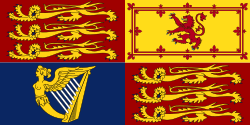The More
Coordinates: 51°38′02″N 0°26′18″W / 51.634014°N 0.438408°W
- This article is about the Tudor palace and is not to be confused with the 17th- and 18th-century house, Moor Park located 1 mile to the south-west.
The More (also known as the Manor of the More) was a 16th-century palace near Rickmansworth, Hertfordshire, England, where Catherine of Aragon lived after the annulment of her marriage to Henry VIII. It was previously owned by Cardinal Wolsey, and was located at the north east corner of the later More Park estate on the edge of the River Colne flood plain.[1] The Treaty of the More was celebrated here by Henry VIII and the French ambassadors.[2] In 1527, the French ambassador, Jean du Bellay thought the house more splendid than Hampton Court.[3] Nothing now remains above ground. The site is a scheduled ancient monument.[4][5]
History
The site was inhabited in the 12th century, or earlier. The house came to Wolsey as a possession of the Abbey of St Albans in 1515, and passed to Henry VIII in 1531. By the mid-16th century, there was a timber-framed long gallery 15 feet broad and 253 feet in length. Most of the house was made of brick. Catherine of Aragon came to live at the More in the winter of 1531/32. The house was redecorated by the painter John Hethe with the Queen's badges (the ciphers of Anne Boleyn) in 1534, and in 1541 Hethe painted the king's bedchamber with blue bice and fine colours. Stained glass was installed by Galyon Hone. Provision was made in 1542 for the king's archery, and two deer-barns were built. There were even two grandstands to watch the hunting. It seems that the building was abandoned after 1556 and may have had inadequate foundations.[6] It was demolished in 1661.
The royal inventory of 1547 listed 157 items at the More in the care of Richard Hobbes. Ten of the suites of tapestry had borders with Wolsey's coat-of-arms. Two crimson velvet chairs were embroidered and carved with Anne Boleyn's initials.[7]
The site was part excavated between 1952 and 1955. It is currently buried under a metre of imported top soil placed to provide a level playing field for Northwood Preparatory School which lies immediately to the east.[8] The site was also the subject of an episode of the popular archaeology TV programme, Time Team in 2012.[9][10][11]
References
- ↑ p.77, Robert Hutchinson, The Last Days of Henry VIII
- ↑ Stephen Gardiner, English bishop and Lord Chancellor Luminarium Encyclopedia. Accessed 9 February 2015
- ↑ Pollard, A. F., Wolsey, (1929), 325; or Guillaume du Bellay
- ↑ Historic England. "Manor of the More (1015595)". National Heritage List for England.
- ↑ Manor of the More, Moor Park Three Rivers Museum, Accessed 7 February 2014
- ↑ Colvin, Howard, ed., The History of the King's Works, vol. 4 part 2, HMSO, (1982), 164-169, with conjectural plan.
- ↑ Starkey, David, ed., The Inventory of Henry VIII, vol. 1, Society of Antiquaries, (1998), nos. 13334-13491; chairs no. 13423
- ↑ Rykmersworth; Moor Park Gatehouse-Gazetteer, comprehensive gazetteer and bibliography of the medieval castles, fortifications and palaces of England, Wales, the Islands. 31 December 2014. Accessed 7 February 2015
- ↑ Northwood Time Team excavation , Channel 4. Accessed 7 February 2015.
- ↑ "TIME TEAM PHOTOS AND CLIPS". Northwood Prep School. Retrieved 10 February 2015.
- ↑ "TV's Time Team visits Northwood Prep School". Watford Observer. 30 April 2012. Retrieved 10 February 2015.
Bibliography
- National Heritage List for England Scheduled Monument Number 1015595, Legacy Scheduled Monument Number 29381
- English Heritage (PastScape) Defra or Monument number(s) 395304.
- County Historic Environment Record (or Sites and Monuments Record) number(s) 829; 10919.
- Renn, D.F., 1971, Medieval Castles in Hertfordshire (Chichester: Phillimore) p. 22
- Salter, Mike, 2002, The Castles of The Thames Valley and The Chilterns (Malvern: Folly Publications) p. 49 (slight)
- Thurley, Simon, 1993, The Royal Palaces of Tudor England (Yale University Press) p. 44, 50, 58, 74, 78, 114-5, 173, 192, 193
- Keevill, Graham D., 2000, Medieval Palaces, An Archaeology (Stroud; Tempus) p. 30, 62-4, 70, 154, 163

.svg.png)